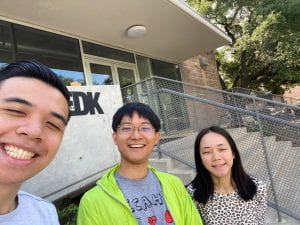Hi!
My name is Andrew, and I am a rising sophomore planning to major in Bioengineering. I aim to incorporate my perspectives regarding health from the health professions and civic leadership viewpoints to create human- and community-centered solutions for healthcare challenges.
I come to SEED having taken an introductory engineering design course the semester prior. What stood out about that course, which also influenced my decision to apply to SEED, was how self-directed it was. Rather than tasks or instructions, my team and I were given a project to be developed from the bottom-up. Although the user needs and client flagged an approximate destination, our team was free to prioritize our own values and choose our own path in designing a solution. Along the way, my team and I stumbled, compromised, panicked but also learned new skills, succeeded, and made something we could call our own. In the end, I can best liken the appeal of such an experience for me to one thing: an adventure.
My first week as a SEED intern reminded me of the excitement I felt in that course. After the first day’s orientation, I met my team members with whom I would collaborate to create a manikin used for training nurses in Malawi to perform Ballard scoring. The assessment is a valuable tool for evaluating a neonate’s gestational age, especially in low- and middle-resource countries where menstrual history and ultrasound are often inaccessible. After establishing rapport, our team quickly worked on setting our own group culture. After (perhaps a little too) much deliberation, we even settled on a charming name, NIMBS, standing for Neonatal Instructional Model for Ballard Scoring. We also set up a (very serious) procedure to adjourn meetings (see the video).

The NIMBS Design Team. From left to right: Lam, Me, Gloria.
This week, we conducted extensive research to clarify our team assignment. Our team took a critical approach when considering our project’s scope and parameters. One focus was investigating other gestational age assessment methods besides Ballard scoring to ensure that our eventual training manikin would help teach the most effective assessment. We also looked to confirm that a training model would address the underlying problem of Ballard scoring not being performed enough in hospitals in Malawi. Our concerns regarding whether better training would encourage senior nurses to adopt Ballard scoring and potential barriers to implementing a new training manikin into the healthcare educational curriculum are driving our efforts to meet with more stakeholders in the coming week.
In SEED, a lot of time is allocated for teams to work independently, but even more structured aspects of the program seem guide rather than supervise. Morning standup has become one of my favorite scheduled activities. The project teams gather, and each group shares its progress, challenges, and next steps. Learning about what other teams are doing is quite motivating, and even in the short time since SEED’s start, we have begun to diverge. Our project is human-centered, so we have spent considerable effort trying to contact stakeholders. Meanwhile, other groups have already laid foundations to support future technical work.
The opportunity to develop one’s own group culture, challenge assumptions in the team assignment, and be guided but not supervised, is one that not every workplace can offer. As my team and I move forward with this project, I am sure that we will run into hurdles to overcome. Yet, knowing that I will be working toward something I believe in, in a direction I help to decide, makes these eventual challenges seem like a valuable part of the journey rather than something to be dreaded. After all, what is an adventure but for the element of risk and reward?
Until next week,
Andrew Sun
